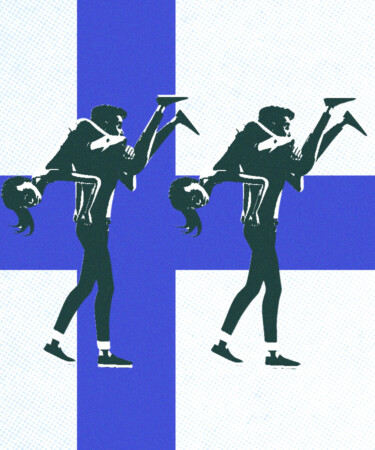From Germany’s mud Olympics to the United States’ mashed potato wrestling competitions, weird sporting events are a global tradition. But in Finland, one of the strangest takes place every summer: eukonkanto, or wife-carrying. During the competition, male competitors sling their partners over their backs and carry them through a 253.5-meter (831 feet) obstacle course. Making matters stranger? The winning team is paid in beer — enough to match the exact bodyweight of the carried partner.
Though the competition was not established until the early ‘90s, its roots appear to trace all the way back to the 1800s and a forest-dwelling robber in Finland by the name of Herkko Rosvo-Ronkainen, a.k.a. Ronkainen the Robber, who made a living by thieving and pillaging neighboring villages with his gang of bandits. One theory suggests that the race is an evolution of Rosvo-Ronkainen and his gang’s habit of stealing food and women from nearby towns, running away with the women carried over their backs. Another legend argues that they specifically kidnapped other men’s wives from these villages, similarly fleeing with them on their backs before forcing them to become their own wives. The third — and least misogynist — theory points to Rosvo-Ronkainen’s training measures. It is believed that in order to join the gang, prospective members were required to carry extremely heavy bags through a course riddled with boulders and streams that only the fastest and strongest could survive.
The first official wife-carrying competition was held in Sonkajärvi, Finland, in 1992, and the rules were simple — so simple that they haven’t changed since. The female partner, who doesn’t actually have to be the male partner’s wife, must be at least 17 years of age and weigh at least 49 kilograms (108 pounds). If she doesn’t meet the weight requirements, she must carry a rucksack with the additional weight. Male partners, who are each required to wear a supporting belt, then carry their helmeted female partners through the course, which contains a water obstacle and two dry obstacles.
Each year, approximately 80 competitors join the race with two couples participating in each heat, the fastest of which progresses to the next round. In the final heat, the first couple to the fin(n)ish wins the grand prize — the carried partner’s body weight in brews. To establish just how much beer to distribute to the winners, the carried teammate sits on one end of a teeter-totter as beer is placed on the other until perfect balance is achieved. Prizes are also given out to the second and third place teams, as well as the couple with the best costume and the couple carrying the heaviest weight.
While there are no rules regarding how the female partner must be carried, most winning teams find the most success with the Estonian-style hold, which sees the wife carried upside down on the male partner’s back with her legs over the neck and shoulders. It was this technique that earned Margo Uusorg and Sandra Kullas, both of whom are Estonian natives, the world-record time when they finished the course in 56.9 seconds in 2006.
The competition has become so beloved — likely for its craziness — that it’s inspired similar races in countries outside Finland. The U.S. has been hosting its own wife-carrying competition since 1999, Australians have participated in their country’s race since 2005, and the U.K. has put on its annual competition since 2008. In 2013, BBC presenters Steph McGovern and Mike Bushell were the first to flip the race’s gender roles when McGovern carried Bushell over the finish line. Similar contests are also held in Germany, India, and Hong Kong, with the winners of each receiving an invitation to represent their home country at the Wife-Carrying World Championships in Sonkajärvi.
This year’s world championship kicks off on July 5 with the official race taking place on Saturday, July 6. Who will take home the gold — and its accompanying brews — this year? Only time will tell.
*Image retrieved from LIGHTFIELD STUDIOS via stock.adobe.com
